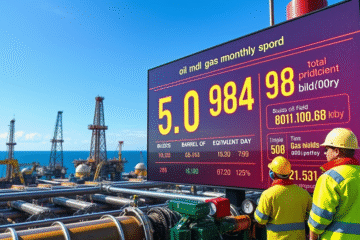OPEC+ Increases Daily Oil Production
Daily Production of oil is a constantly evolving topic in the global economic landscape.
OPEC+ recently announced a production increase of 137,000 barrels per day starting in October, as part of a broader gradual recovery strategy.
In this article, we will explore the decisions made during the virtual cartel meeting, the implications of this shift in focus to market share rather than price, and the challenges member countries face in terms of capacity and domestic pressures.
We will also discuss how factors such as the trade war can impact oil demand.
OPEC+ decision on gradual increase in oil production
OPEC+ decided to implement a gradual increase in daily oil production, with an initial increase of 137,000 barrels starting in October.
The plan calls for reaching 1.65 million barrels per day by next year, reflecting a cautious strategy given global market conditions.
This decision comes as cartel members seek to balance market share and price pressure.
Priority given to market share over prices
The decision of the OPEC+ of prioritize market share to the detriment of oil prices reflects a bold strategy aimed at securing a competitive position in the global market.
During a virtual meeting recently, cartel members have emphasized the importance of consolidating market share.
According to a delegate present: “Stable market share is more sustainable than immediate high prices.”
This approach seeks to mitigate the impacts of price fluctuations, allowing for more efficient adaptation to global economic changes.
With a staggered increase in oil production, the OPEC+ aims to respond to internal pressures and capacity constraints in some countries, while maintaining a competitive presence.
This strategy is also a response to the trade war, which affects global demand. "Our goal is the long-term resilience of the oil market," another representative emphasized, highlighting the intention to balance market control with future profit potential.
This approach, while challenging, can offer a significant strategic advantage in the face of dynamic changes in the global market.
Production limitations and internal pressures in member countries
Actual oil production among OPEC+ members suffers from internal pressures and capacity limitations, directly affecting the actual volume of barrels produced.
Key countries face significant challenges in expanding their production capacities due to financial and technological constraints.
These difficulties result in a lower level of production than originally planned.
Furthermore, factors such as inefficient resource allocation, the need for infrastructure investment, and political instability can further reduce productive potential.
- Country A facing budget constraints to invest in advanced technology
- Country B dealing with political uncertainties that affect strategic planning
- Country C with insufficient infrastructure to increase capacity
To understand more in depth, see the comprehensive article on OPEC+.
Influence of demand concerns and global economic factors
To the concerns about the global economy have a significant weight in influencing the demand for oil.
Trade conflicts can trigger a domino effect, decreasing energy consumption.
According to the DW Brazil, the trade war affects the supply and demand of oil, adding uncertainty to the market.
These factors could cause a significant change in OPEC+ production plans, leading to strategic adjustments.
Below is a brief comparison:
Factor Impact Trade war Demand reduction Economic pressures Production adjustments
Next OPEC+ meeting
OPEC+ is preparing for its next official meeting scheduled for October 5th, a crucial moment to evaluate current strategies in the face of market fluctuations.
During this meeting, members are expected to discuss the possibilities of adjusting their production targets, considering aspects such as the global trade war and its impact on oil demand.
As mentioned in recent news about increased production, the decision to prioritize market share over price has been a strategic move.
However, capacity constraints faced by some countries may influence the continuation of these adjustments.
Therefore, it is expected that the decisions taken at the October meeting will directly impact the pace of production growth, making it crucial to observe how each OPEC+ member country manages to follow the established guidelines.
Daily Production It is a crucial issue that will be reflected not only in the economies of the producing countries, but also in the global market.
The next steps of OPEC+ and its ability to adapt to economic pressures will be key to determining the future of the oil sector.



0 Comments